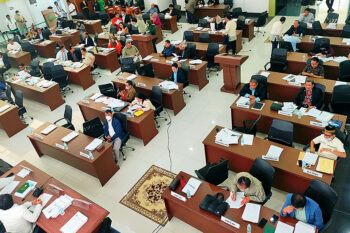
NAAWAN, Misamis Oriental (MindaNews / 27 May) – It is the start of the typhoon season again. In fact, super typhoon Mawar is now at our doorstep after walloping Guam in its path into a complete wreck.
As an archipelagic country that faces the Pacific Ocean, about 20 typhoons enter the Philippines area each year, of which six to nine make a “landfall,” and five of which may likely be destructive. Typhoons often hit northern Luzon from June to August and smash at the Bicol region and eastern Visayas in the month of September to December.
Typhoons entering the Philippines originate from the warm South Pacific Ocean. They are intense circular storms characterized by low atmospheric pressure, high winds, and heavy rain. Drawing energy from the sea surface and maintaining its strength as long as it remains over warm water, a storm is considered a typhoon when it generates winds that exceed 119 km (74 miles) per hour.
In extreme cases winds may exceed 240 km (150 miles) per hour, and gusts may surpass 320 km (200 miles) per hour. Accompanying these strong winds are torrential rains and a devastating phenomenon known as the storm surge, an elevation of the sea surface that can reach 6 meters (20 feet) above normal levels. This is what happened during the onslaught of Typhoon Yolanda (Haiyan) in Tacloban on November 8, 2013. Yolanda killed 6,300 people, injured more than 28,000 , and destroyed P95.48 billion worth of infrastructure, properties and crops.
With the increasing warming of the oceans in the advent of climate change, typhoons or hurricanes worldwide have become more ferocious and devastating than ever.
We cannot avoid typhoons. They are a reality in Filipino life that we can’t help but accept. We can only reduce their impact, say, on the loss of lives and property, by preparing for it.
Escape the typhoon’s wrath by evacuating to safer grounds and shelters. Don’t be forced out of your home; be ready to move at the right time.
If the forecast is a slow-moving typhoon, then expect heavy rains that may cause raging flash and deep waters to follow in the typhoon’s wake. Seek higher grounds.
On September 26, 2009, Ondoy (Ketsana), a weak moving tropical storm which was only upgraded to a typhoon when its wind speed reached 120 KPH upon entering the country, brought tremendous rains even days earlier, ravaging many provinces in Luzon and submerging Metro Manila in a record breaking flood level to as high as 5-6 meters. Ondoy adversely affected 5,000,000 people of which 464 were killed, 529 were injured and 37 reported missing.
The slowly moving tropical storm Sendong (Washi), with a wind speed of only 95 kph, dropped rain bombs for some 3 hours that caused flash floods in Cagayan de Oro and Iligan, killing 1,600 residents in December 2011.
If the forecast is a strong and fast-moving typhoon, seek strongly-built shelters, away from tall and big trees and beyond the reach of a storm surge.
In December 2021, a 5-meter storm surge triggered by Typhoon Odette (Rae) wiped out some 4000 houses in some coastal communities in Sogod, Southern Leyte. Luckily, no fatalities were reported.
Readiness for a typhoon demands that you can move your loved ones with relative ease when advised to evacuate; that some amount of ready-to-eat food had been packed earlier; dry clothes and sleeping materials kept in a waterproof container; and important documents like land titles, birth certificates, transcript of records, diplomas, bank books, and your Bible, secured in a watertight holder, all ready to pick up at the right moment. In situations like this, a flashlight and a utility knife are a must to have. Never forget them. Be sure your cell phone and power bank are fully charged.
Every child of age must carry his own backpack of provision and personal items.
Travel light as much as possible. When you have already secured the most important items, move; don’t look back on things you have to leave behind, you might lose precious time on your safety.
(MindaViews is the opinion section of MindaNews. William R. Adan, Ph.D., is retired professor and former chancellor of Mindanao State University at Naawan, Misamis Oriental)







